Colorado Football Offensive Preview
Cal is probably Colorado's best chance at a win this season. Will the Bears overlook the Buffs?
You know that old Halloween prank where someone lights a bag of dog poop on fire, leaves it on the front porch, rings the doorbell and runs? You have no choice but to stomp on the dog poop, lest your entire house catch fire and burn to the ground. Well, the Pac-12 is ringing Cal’s doorbell this Saturday, and I hope that Cal’s season house in not engulfed in flames.
This season has gone very poorly for the 0-5 Colorado Buffaloes so far: after their last game, they fired 2020 Pac-12 Coach of the Year Karl Dorrell. Colorado has the worst offense (13.4 points/game) and defense (43.2 points allowed/game) in the conference, and sits near the bottom of the entire FBS (ranked 126/131 in offense, 129/131 in defense). As a brief aside, Cal is 11th in the conference in offense with 25.8 points/game—almost double Colorado’s points/game—just to show you how big that gulf is between Colorado and the rest of the conference (Cal is 4th in defense, allowing 22.0 points/game).
So imagine that feeling you get when you watch the Cal offense, and realize it’s almost twice as bad watching the Colorado offense. And then imagine you feel that way about the defense, too. That’s Colorado.
The offensive coordinator (and former Western Kentucky head coach) Mike Sanford has taken over as the interim head coach. At WKU, he lasted two seasons before being fired, posting the third lowest winning percentage of any WKU coach of all-time. And that was with an NFL-bound quarterback at WKU in Mike White. Don’t feel too bad for him though, before that he was a Stanford assistant coach under David Shaw and then the Notre Dame offensive coordinator.
With a new coach and an extra week to prepare, there’s no telling what Colorado will try to do, but Colorado surely recognizes that this game is their best chance to avoid a winless season. In the previous couple of games, Colorado had seemingly given up on this season, and was just playing true freshmen for most of the game.
Will Sanford stick with the freshmen, or will he go back to one of Colorado’s other two more experienced quarterbacks that have also started games this season? Will he keep the same offensive system, or will he try something completely new, something they haven’t put on tape yet? We’re about to find out.
Quarterback
Who’s the quarterback? I have no idea. Colorado has started three different quarterbacks so far this season: last year’s true freshman starter, Brendon Lewis, Tennessee transfer JT Shrout, or this year’s true freshman starter, Owen McCown.
Let’s start with Owen McCown, Colorado’s most recent starter. Owen McCown is the son of longtime journeyman quarterback Josh McCown, and he has honestly played well so far, given the circumstances of, you know, playing for Colorado.
For the most part, Colorado has given McCown the freshman playbook: short, safe passes, a lot of checkdowns, avoid taking unnecessary risks, etc. However, the few times he has taken shots down the field, he showed some nice touch on his throws:
McCown is just mobile enough on his feet that I’m not sure if he qualifies as a dual-threat quarterback or not (the stats probably won’t help you decide here, either: he ran for 43 yards against Arizona, but -32 yards against UCLA). There is the threat of the run, and he’s quick enough on his feet to buy time in the pocket, but he’s definitely a throw-first type of quarterback:

For whatever reason, Colorado loves finding true freshman quarterbacks that they can then play for all 4 years: Sefo Liufau, Steven Montez, Brendon Lewis, etc.
Not particular to Colorado, but players like the ones listed above tend to play with freshman guts: if they aren’t the established starter, they will absolutely absorb big hits trying to make a play, and only when the job is secure do they start to slide on runs and so forth to live to see another down. If you feel like any series could be your last, you are a lot more willing to eat some shots:

Perhaps a better example of the types of hits McCown has taken in order to make a play:

As I mentioned before, although McCown is probably not going to Cam Ward all over the backfield, he’s at least sufficiently mobile that the defense will need to account for him:
McCown is usually using his legs to buy time in the pocket to make the throw, however:

Unrelated to anything in particular, but with UNLV’s Doug Brumfield, Colorado’s Owen McCown, and Washington’s Michael Penix Jr. next week, Cal is facing an unusual number of lefty quarterbacks this season.
Speaking of Brumfield, Owen McCown is pretty much the polar opposite in the way he throws the ball. While Brumfield would throw absolute lasers at all his receivers all the time, McCown does the opposite and puts a ton of air under the ball on his throws:
This is an accurate throw, but with this Jake Browning type of rainbow, it gives the safeties plenty of time to react and make plays on the ball. Here’s an example of where the pass worked:

And here’s one where it didn’t:

As a young quarterback, he’s made a few freshman mistakes (and don’t forget about the whole high school Covid-season thing, meaning even less experience that usual). Here he stares down his first read, telegraphing his intentions to the linebacker:

Of the three Colorado quarterbacks that have seen meaningful playing time, Owen McCown is looking like the sharpest of the bunch. He’s playing well for the most part and definitely has potential.
Colorado’s starting quarterback last year was Brendon Lewis. Lewis is definitely a dual-threat quarterback, with a stronger arm and the ability to run when the play breaks down. Unfortunately for Colorado, he seems to have regressed since last year, and has made plenty of bad reads and poor throws this season. He’s got the higher ceiling, but he’s not currently playing like it.
I’m going to cheat a little, but here’s a Brendon Lewis throw from last season:
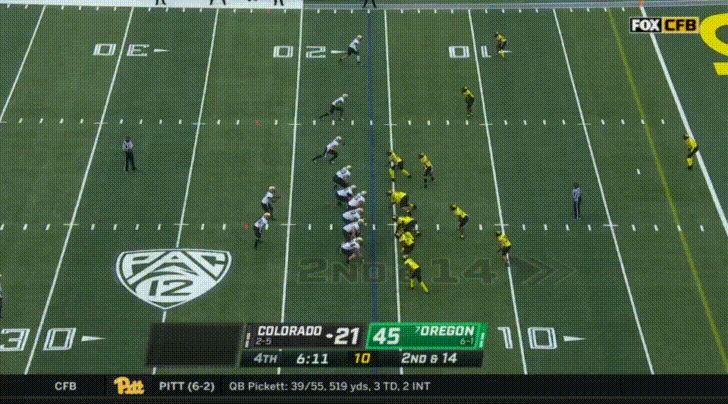
And here Lewis in the opening game of the season showing some really nice placement on the throw down the sideline:
On the other hand, Lewis also had some inexplicably bad throws like the following, which led to him ultimately getting benched:
It’s almost like the longer you play in Colorado’s system, the worse you get.
After Brendon Lewis, Colorado gave the Tennessee transfer QB JT Shrout a shot. Shrout missed the entire last season with an injury, so this was his first game action in a while.
Also like Lewis, he had some nice zip on his throws, and trusted his wide receivers to make plays:
Like Lewis, he also had some bafflingly bad throws which led to him also getting benched:

The above play miraculously worked out, but I think it was plays like the following from Colorado’s most experienced quarterback that contributed to Shrout getting the axe:
In the third game of the season against Minnesota (Lewis started against TCU, Shrout against Air Force), Colorado alternated drives between Lewis and Shrout before finally throwing up their hands in the midst of a 49-0 beating and decided to give the true freshman Owen McCown some snaps. Maybe he’s not lighting the world on fire, but at least he’s throwing in the general vicinity of his receivers, instead of throwing the ball into the dirt or into the chest of defensive backs.
Running back
Colorado’s best running back coming into the season, Alex Fontenot, has been out with an injury and is currently questionable for Saturday’s game against Cal. Last year, I commented on Fontenot’s nice vision and speed, but he’s been slow to get moving this season. Part of the blame lies with the Colorado offensive line, which has struggled to open run lanes for Fontenot, so I don’t have any current highlights of Fontenot from this season prior to his injury.
In his place, Deion Smith has stepped up and founds his way into the starting role. Smith, probably the fastest of the running backs, is a threat in both the run- and pass-game:
In addition to his nice balance, he can also make some nice cuts:
Here he shows some speed:
A surprise this season is the former walk-on Charlie Offerdahl. He’s a bit undersized, but he shows some nice vision and elusiveness:
Contrary to my usual size and speed stereotypes, Colorado RB Anthony Hankerson breaks the mold. On paper, he looks like he’s a bit undersized, but he plays like a power running back:
Here’s another such strong run up the middle:

Finally, redshirt freshman Jayle Stacks is the power runner back, but he is currently listed as questionable for the game with an injury.
Although Colorado has struggled a lot this season, the run game is one of the few bright spots so far. Well, relatively speaking, anyway (they’re last in the conference in passing yards per game, passing TDs, and rushing TDs, but they’re 11th in rushing yards per game; so they at least have that going for them, I guess).
Receivers
I figured I would have started this section off talking about the tight end, Brady Russell, last year’s leading receiver (especially since the second leading receiver, WR Brenden Rice, has since committed unspeakable horrors; namely, he joined USC). Unfortunately, like many Colorado veteran players, he’s also regressed this season, posting a mere 7 catches for 52 yards so far (with a large chunk of them on that accidental Shrout throw I posted above).
Here’s a highlight from 2021 that I didn’t put in last year’s article:
He’s a big dude with good hands, and a reliable short yardage target. Why Colorado hasn’t used him more, I don’t know. He’s also listed as questionable for Saturday’s game, so I am not even sure if Cal will see him or not.
Colorado’s best receiving threat is Daniel Arias. He is a good route runner, and he shows an ability to adjust to the ball, which is a must when being on the receiving end of Colorado’s quarterbacks.
He’s a sure-handed receiver:

Although, a lot of times I feel like it’s not so much that Arias is making a great play over the defensive back, so much as it is the defensive back beating himself on the play. Check out any of the Arias clips above and I think you can see what I mean.
The other receiver worth watching is the true freshman Jordyn Tyson, who was already featured above on the receiving end of a number of those QB highlights. Tyson shows a ton of promise, and with proper coaching (read: doesn’t regress like most other Colorado players), I think he can be really good.
Here he is making a nice diving catch for the touchdown, in a very difficult spot to defend:
His speed and reliable hands have quickly made him the #2 receiver behind Arias.
If all goes well for Cal, I probably don’t need to cover any other receivers in this section. So how about some short blurbs?
Maurice Bell is the speedster, the player Colorado will try to get the ball to in space, either on jet sweeps or for quick catch-and-run plays. Montana Lemonious-Craig is another receiver that does well in open space, and also shows some nice hands. Ty Robinson is a true sophomore receiving his first meaningful playing time, but I’ve noticed him most often on the receiving end of big hits to break up the catch. RJ Sneed was a much-hyped grad transfer from Baylor, but he’s somehow been buried on the depth chart behind some of these other guys, so take that for what you will.
Lastly, if Brady Russell is out, expect a rotation of the other tight ends: Caleb Fauria, Austin Smith, and Erik Olsen. I think Fauria has shown some potential, but the only highlight-worthy play of the group belongs to Austin Smith for this catch:
Not a lot of players make this catch, but the above clips is fairly emblematic of the Colorado offense: the receivers need to make some really good plays to bail out the quarterback, and it’s tough to do on a consistent enough basis to sustain drives.
Special teams
Colorado’s kicker, Cole Becker, has a strong leg, and posted a career-long field goal of 56 yards as a true freshman (in Utah, which has a high elevation, but not as high as Colorado).
Punting, on the other hand?
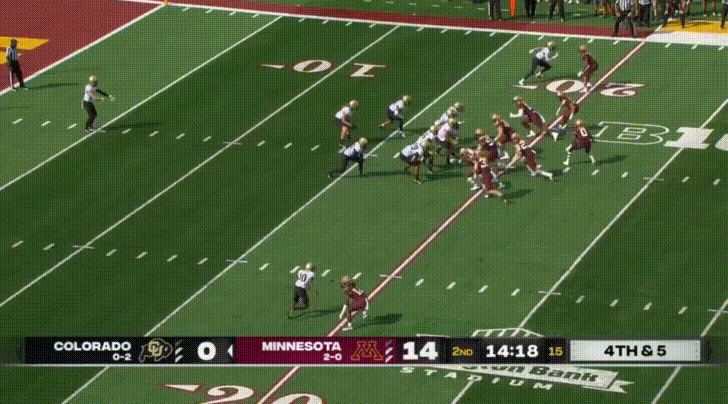
I don’t expect a close game, but if it were a battle of field position, I think Cal would have the upper hand.
Conclusion
This should not be a close game, and I will be a bit concerned for Cal if it is. Best case scenario for Colorado is that Cal overlooks them in favor of the Washington matchup the following week, while Colorado debuts something new and confusing that Cal hasn’t prepared for. Even so… Colorado’s main issue this season, in my humble opinion, is that their talent has been vastly underperforming (if I want to talk about a certain player, and I need to reach into my “2021” folder to find examples of what I am talking about, it’s probably not a good sign). They have good quarterbacks that are playing terrible, such that a freshman unpolluted by Colorado coaching has become their best option. They have good running backs, but their offensive line struggles to open up holes for them. They have a couple decent receivers, but they need to go above and beyond to make plays due to subpar throws. Add this all up, and you can see why Colorado struggles to string consistent drives together to score. I don’t think Colorado can fix their issues in two weeks, and so if Cal can avoid major mistakes (like a large number of costly turnovers), they should be able to handle this game easily. Tomorrow, in the defensive preview, I’ll detail why I think Jaydn Ott will run for another 200+ yards, given that Cal feeds him the ball.
Go Bears.
You can find my full clips here.




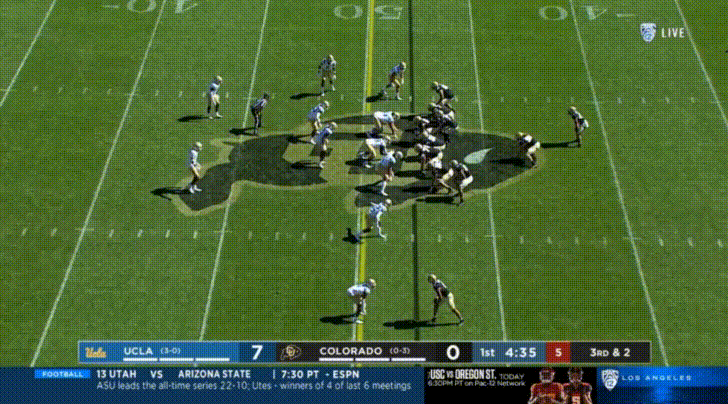

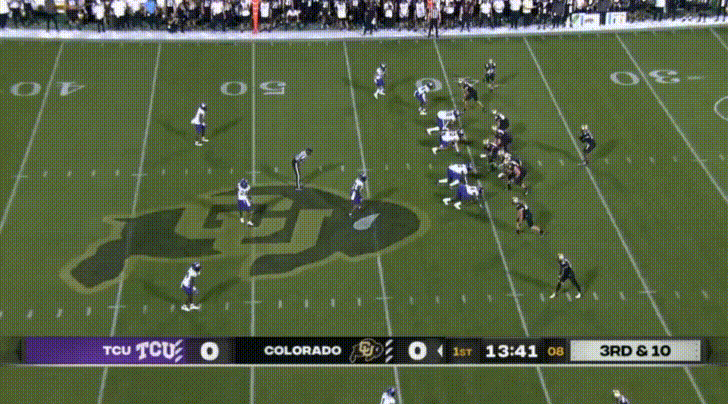





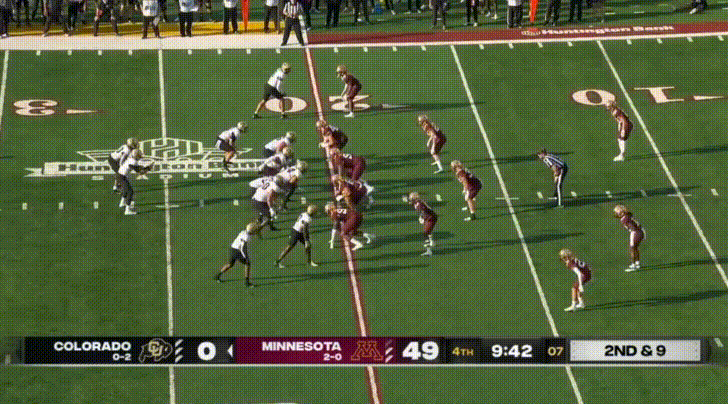
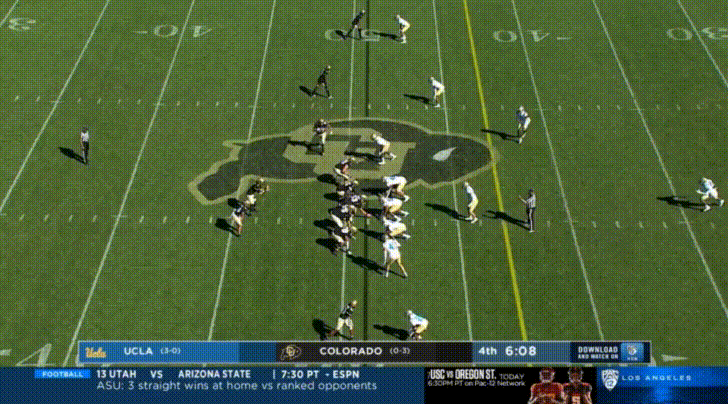





Thanks, Christopher. I truly appreciate the time and effort you put into these previews. I don't mean to get greedy, but this is a game where Cal should have a comfortable lead and allow Kai Milner and second unit players to get substantial fourth quarter playing time. This to me would signal course correction after the disaster in the Palouse.
Really nice write-up. I agree that Cal should be able to salt this one away as a victory. I don't think we should be overlooking anyone at this point.